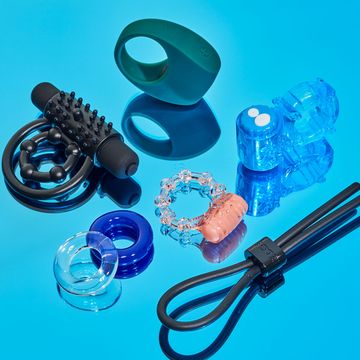Sure, nipple piercings are about as shocking as cartilage piercings now, but there are still some piercings that remain taboo to the average person. When it comes to penile piercings, there’s a ton of fascinating info out there that you might not know. Thankfully, Robert J. Cornell, MD, a practicing urologist in Houston; Alex Shteynshlyuger, MD, director of urology at New York Urology Specialists; TJ Cantwell, owner of Studio 28 Tattoos in New York City; and Saylor and Vicki Rose, piercers at Studio 28, explain everything you’ve ever wondered about penis piercings.
1. Prince Albert piercings can last a LONG time.
Vicki says she’s seen some piercings that are older than 38 years. “Similar to earlobe piercings, once some clients decide to get the piercing, they may keep it their entire lives,” she says.
2. Wearing tighter undies after you get a penis piercing is a good idea.
Vicki recommends anything but boxers, as tighter clothing will help hold the bandage in place so there’s minimal movement.
3. The longer you can wait to masturbate after getting freshly pierced, the better.
Accidentally hitting the piercing during masturbation can set back healing and make it take longer. Vicki says if you can manage to wait a month, that’s best.
4. Erections might be more painful.
I mean, if an erection is a ton of blood rushing to an area, having an open wound there at first might not feel super great. “The penis is already a very vascular area, so bleeding can happen and is normal,” says Vicki.
5. You might have to wear a diaper or some other form of bandaging for a few days.
Vicki suggests diapers for clients who are heavy bleeders. Otherwise, gauze or hygiene pads can work as an initial bandage to catch heavy bleeding. Vicki also uses gauze with a nitrile glove around the area and medical tape to control any bleeding for the first few days. Basically anything to make sure you’re not bleeding through your clothes.
6. They might not be as uncommon as you think.
In New York City, where Vicki works, she says Prince Albert piercings are very popular. But, she notes, this could also be due to the fact that a populous city like New York has a ton of people and less piercers performing genital piercings. Vicki adds that most days, she’s helping someone with a penis or vulva piercing.
7. The apadravya (which passes through the head of the penis) could actually cause erectile dysfunction.
Cornell explains that the piercing could create a “shunt where arterial blood from the erectile chambers of the penis leaks back through the blood in the head of the penis.” To make matters worse, this complication may not be repairable. However, he notes that the Prince Albert and frenulum piercings wouldn’t be expected to cause this problem, so if you’re concerned, you still have two options to choose from.
8. The most common piercings are the Prince Albert and frenulum piercing.
Saylor says there are a lot of male genital piercings and new ones are being thought up all the time, but these two piercings are the most common. The frenulum piercing is a small curved barbell that goes horizontally through the underside of the penis. The Prince Albert “is a ring that travels through the urethra out of the lower head of the penis,” and a reverse Prince Albert travels through the upper head of the penis.
9. The most painful penile piercing is the apadravya.
The apadravya is a vertical straight barbell that travels through the urethra through the head of the penis from top to bottom. Saylor says it is also one of the least common types of male genital piercings.
10. A lot of men get penile piercings with their partners.
Saylor says he has a lot of clients who will come in with their significant other to get a piercing done, and some couples even come in and both get genital piercings done together to have the experience as a bonding moment. It’s not a “holding hands in adjacent tubs like a Cialis commercial” type of bonding, but bonding is bonding, I guess.
11. There’s no magical intra-penile G-spot that getting a piercing will hit.
“It does not appear that typical piercings cause any significant sensitivity or pleasure for the guy. Most men get the piercings for aesthetic reasons and to increase female pleasure,” Dr. Shteynshlyuger says. So while some guys might anecdotally say it increases sensitivity, there’s no hard science to back it up.
12. If the whole reason someone’s considering a penile piercing is to please their partner in bed, Dr. Shteynshlyuger says to skip it.
“The quality of erection—its rigidity, hardness, and endurance—is much more important to great sex than a piercing on the penis. Piercings cannot compensate for erections that are not hard enough or don’t last long enough.” But guys might also do well to remember that listening to your partner and going down on them with enthusiasm and frequency can also make for supes-great sex, BUT I DIGRESS.
13. They should only get pierced using implant-grade materials.
Cantwell says to be wary of body jewelry that uses nickel or other metals, since you may be allergic.
14. Anyone considering a penile piercing should talk it over with the piercer to see what style will be best for their specific anatomy.
Cantwell says the style of jewelry used on a piercing varies from piercing to piercing and from person to person. The best way to make an informed decision is to meet with a professional piercer and discuss. There’s no easy answer on the internet that can replace an IRL consultation. “Unfortunately, the style of jewelry being different is really on a case-by-case situation as to what can and cannot be done....That is why at our shop, we always have a consultation with the client to determine what suits their needs and wants best. Any shop should do this with their clients.”
15. Know how to find a legit piercer.
Cantwell says finding a legit piercer can be difficult because a lot of people talk good game, but there are certain red flags to look for to know if it’s not legit. “They should be working with implant-grade materials only. Even at the counter, the jewelry should never be handled with bare hands. If a shop takes jewelry out of the case to show a customer, this would not be proper handling of the jewelry as it will eventually be put through someone’s body.” A reputable piercer should also provide their clients with verbal and written instructions on how to care for a new piercing. Cantwell says his studio recommends using a sterile wound wash twice a day to remove buildup or discharge around the piercing.
16. Penile piercings can cost upward of $120.
Keep in mind that you get what you pay for. “If you are getting a piercing for $20, it is not quality,” Cantwell explains. “To do sterile procedures with implant-grade metals, a minimum pricing [for a regular piercing] would be in a $60 to $90 range, with jewelry included. Genital piercing clients would expect to see pricing upward of $120.” Also make sure all materials used for the piercing are individually packaged, sterilized, and opened in front of whoever’s getting pierced. Make sure the piercer is using one needle per hole. Gross but important! “Needles should be single use for each piercing as well, so if you get two piercings, the piercer should use two brand-new needles for you.”
17. A Prince Albert piercing goes through the urethra, which can make healing especially complicated.
Because the new piercing will come into contact with urine from the get-go and mix with blood, this can make spotting an infection especially tricky. Dr. Shteynshlyuger says that during the first 7 to 10 days after a piercing, even experienced urologists can be on the fence deciding whether a small amount of discharge is minor bleeding or the sign of an infection. It’s also possible to have some “whitish fibrous discharge that looks like pus” come out of the piercing, but it might not necessarily be an infection.
18. Some bleeding is not uncommon.
As Dr. Shteynshlyuger explains it, the penis is basically a big blood vessel, so if a piercing goes through the head of the penis or the shaft, a little bleeding isn’t uncommon.
19. Guys might bleed more after their piercing in the mornings.
Saylor says there should be minimal bleeding during the procedure and for the first 72 hours of healing, with any bleeding mostly due to morning erections.
20. Any person considering a penile piercing should know what the signs of infection are before going into it.
Dr. Shteynshlyuger says fever, chills, and increasing pain and swelling warrant a trip to the urologist ASAP. “Normally, the amount of pain, bleeding, swelling, and discharge should decrease day to day after piercing or any other surgery on the penis. If the amount of pain, discharge, redness, or swelling starts to increase, it’s a warning sign.”
21. Certain factors may put someone at higher risk for infection.
Dr. Shteynshlyuger says a penile piercing could be more prone to bacterial and fungal infections (look for whitish discharge or reddish skin discoloration) if the person is uncircumcised, has diabetes, or has a compromised immune system.
22. They’ll have to wait six to eight weeks before having sex.
The healing time for a penile piercing is four months, minimum, but Saylor says they should wait six to eight weeks at a minimum before having sex.
23. Ejaculating will be...different.
Dr. Shteynshlyuger says piercings like the Prince Albert or reverse Prince Albert that go through the urethral meatus (the opening of the urethra on the penis) will change the force and trajectory of ejaculation, so semen won’t “fly out” as forcefully but will go out sideways or drip out instead. So, safe to say sex will be very different post-piercing, in at least one way.
24. A person with a penile piercing might have to sit down to pee.
“Typically, men sit down to urinate [after getting a piercing that goes through the urethra], otherwise urine may splash in different directions,” Dr. Shteynshlyuger says. Saylor adds, “There can be some leakage with urination, but people learn how to work with their jewelry to compensate.”
25. Complications from a penile piercing could lead to erection problems.
Dr. Shteynshlyuger says, “If someone gets a penis infection, sometimes it can get severe enough—especially if not treated early—that it causes scarring in the penis and erection problems. Particularly if the piercing goes through penile shaft, not just skin.”
26. Penile piercings can put someone more at risk for infection than, say, ear piercings, because of the moisture in the area.
Dr. Shteynshlyuger says using a prophylactic antibiotic and proper sterile technique can bring the risk of infection down to less than 1 to 2 percent, but having urine mix with the new piercing increases risk. While urine is mostly sterile coming out of the body, “there are bacteria at the tip of the penis where urine is no longer sterile. Urine drops that spread out at the tip of the penis, in the underwear, and on piercings accumulate infection pretty fast from surroundings.”
27. Someone who has a penile piercing could be more at risk for sexually transmitted infections and urinary tract infections.
Dr. Shteynshlyuger says that while there aren’t any definitive studies about the risk of sexually transmitted and urinary tract infections and penile piercings, “common sense and understanding of microbiology tells that the risk may be increased in men and their partners due to the presence of metal foreign device (piercing) and additional exposed surface area (pierced hole).” He explains that bacteria likes to stick to metal objects, and the area where the piercing enters skin and the inside of the skin tract, if not cleaned well, could be a place for bacteria to hide. After all, open wounds are more likely to get infected, whether it’s a regular skin infection or a sexually transmitted disease.
28. A penile piercing can pose new challenges with condoms.
While not every genital piercing would get in the way of a condom, Dr. Shteynshlyuger says some piercings that go through the tip of the penis, like a Prince Albert, can tear condoms easily. It’s possible to get a condom on over a piercing as long as the jewelry isn’t too large, but keeping the condom on and intact can be tricky. Dr. Shteynshlyuger says that while there aren’t any great options for birth control if you keep ripping through a condom, someone with a genital piercing could use pre-exposure prophylaxis medications for HIV prevention, but other infections could still spread. “The best option is perhaps to get your partner fully tested prior to having sex and hope your partner and you are monogamous.” Saylor also added that because of this problem, many people with genital piercings will remove the jewelry before intercourse in order to wear condoms.
29. If someone chooses to close their penile piercing, they should see a urologist rather than a plastic surgeon.
The likelihood of a piercing closing on its own depends on several factors, including how long the opening has been there, the size of the opening, and where the piercing is. Piercings that have been open for less than three to six months are more likely to close on their own, whereas piercings that have been open for more than six months are less likely to close on their own, Dr. Shteynshlyuger says. However, if the piercing passes through their urethra (like a Prince Albert), they will need penile surgery and urethral reconstruction.















